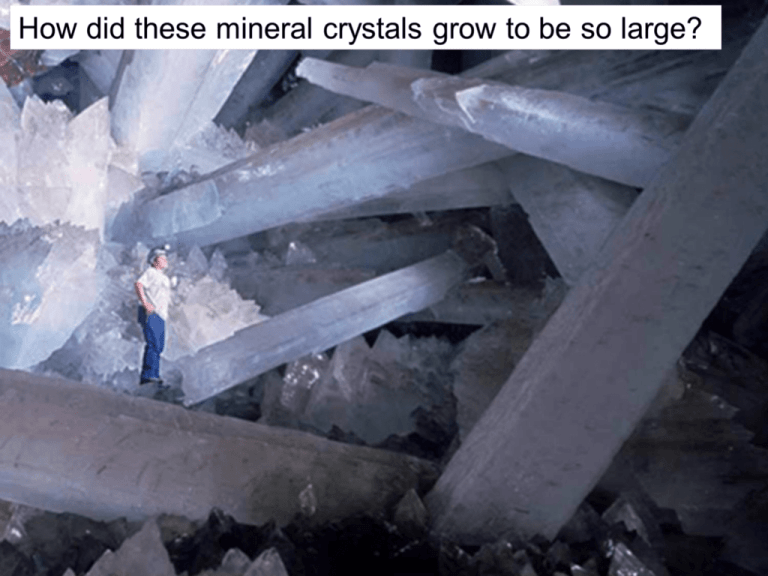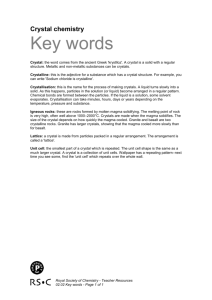How Minerals Form ppt.
advertisement

What is a crystal? How do minerals form? What factors affect the size and shape of crystals? What are the different crystal shapes? The 5 characteristics of a mineral • Solid •Natural (found in nature) •Inorganic (never living) • Orderly internal structure of atoms (crystal structure) • Chemical composition (chemical formula) Mineraloid - lacks an orderly internal structure Unit 4 PHENOMENON: What did you observe? What evidence do you have? Crystal Formation OBJECTS: . What objects are interacting? copper wire and silver nitrate Salt solutions in 100% and 50% concentrations Salol cooling and crystalizing Granite rock crystals Graphite and diamonds Crystal models and crystals samples in well plate MOTION /STRUCTURE Describe the structure that in the model that explains your observations Part A: Making (silver) Crystals http://www.youtube.com/watch?v=bJDeoah -Cd0 snowflake crystals Silver nitrate ‘crystals’ pic from phone • Although not flat surfaces, the silver atoms arrange in a regular repeating pattern Definition of crystal Part B: Concentration and Crystal Formation 1. Ions (such as salt or calcium) are dissolved in water. 2. The water EVAPORATES, and the ions form minerals such as halite, calcite, gypsum, limestone. http://www.classzone.com/books/earth_science/terc/content/inve stigations/es0506/es0506page09.cfm Part C: Crystal and Space http://www.youtube.com/watch?v=HeiMfLmJtzk Mexico's Cueva de los Cristales (Cave of Crystals) contains some of the world's largest known natural crystals—translucent beams of gypsum as long as 36 feet (11 m). Volcanic activity 26 million years ago created Naica mountain and filled it with high-temperature anhydrite gypsum. When magma underneath the mountain cooled and the temperature dropped, the gypsum that had been dissolved for millions of years began to be deposited in the caves in the form of huge selenite gypsum crystals. 100% concentration 100% concentration 25% concentration 25% concentration Draw Particle diagrams to show (model) how the crystals formed out of a solution Salt dissolved in water 100% concentration Water 25% salt solution salt salt arranged into crystals White Board Session review • WB is neat, organized, readable • All members of the group are prepared to explain a part of the WB • All group members are prepared to answer questions about the WB • Address questions and answers to the entire class • No judgment statements –ask good questions • It’s okay to make mistakes –that’s how we learn • Be respectful of the presenters. • Every student is responsible for all the information learned from the discussion Factors that determine crystal size: Concentration Space Time / rate http://www.classzone.com/books/earth_scien ce/terc/content/investigations/es0506/es0506 page01.cfm?chapter_no=05 ES0506 Outside inside Part E: Observe crystals Under a stereoscope, compare the size of the crystals for 3 magma rocks Granite Basalt Obsidian The Magma Process: (pg.97) • Molten (liquid) rock in a magma chamber At, near or under earth’s surface, rises • The magma begins to COOL. The atoms, ions and molecules combine to form various mineral compounds. • The molecules arrange into an orderly repeating pattern to form CRYSTALS. http://www.youtube.com/watch?v=1I5Qc73o5Vk bismuth quartz Rate / Time • The RATE at which the molten magma cools determines the crystal size. • Predict: If the magma cools at a s-l-o-w-l-y (under the surface taking hundreds of years) then the crystals will be… well-formed granite • If the magma cools quickly (weeks) the crystals will be small / microscopic / not well-formed (Look at basalt with a hand lens or scope) • Predict: • If the magma cools at a very fast rate, quickly, then the crystals will…. None example: obsidian a volcanic rock, cools instantly. so it has no crystal structure, but a glass-like structure Crystallization of Salol Lab Slow cooling and crystalizing Quick cooling and crystalizing Part E: Rate of Cooling and Size of crystals in Granite • Granite contains 3-4 main minerals. quartz ________: clear, whitish, transparent Feldspar (potassium) pink, salmon-colored _______________: Hornblende (amphibole) ___________________: black, gray, dull Mica - biotite ________________: black, shiny Each mineral melts / crystallizes at its own temperature between 1300ºC and 500ºC 500°C Rank the order in which the minerals in granite will crystallize. Hornblende (amphibole) • First to cool and crystallize ___________ Biotite mica • 2nd to crystallize ___________________ Feldspar (potassium) - pink • 3rd to crystallize ___________________ quartz • Last to crystallize _________________ So. . . Quartz is the LAST to crystallize, so it is usually shapeless. The kind of mineral that is formed depends on… 1. Which elements are present when it forms 2. The amount of an each element present. * The same magma chamber can form different minerals. Bellwork 1. What is the #1 most abundant element in the Earth’s crust. 2. List the five characteristics of a mineral: 3. What is the hardest and softest mineral on the Moh’s Scale of Hardness? 4. Define a crystal: 5. How does a fast rate of cooling affect the size of crystals? Slow rate? Factors that affect the size and shape of crystals Concentration Space Time / rate Temperature Pressure Where do diamonds form? The Pressure Process: 1. Rock or mineral is exposed to extremely high pressures and temperatures, and the minerals begin to break down. 2. As pressure and temperature increase, the molecules RE-FORM into new minerals! http://www.classzone.com/books/earth_science/terc/content/investigations/es0506/es0506page09.cfm At what temperature and depth does graphite exist? Temp: Pressure: At what temperature and pressure do diamonds form? Temp: Pressure: Compare the properties of a diamond and graphite Color Luster Hardness Cleavage Crystal structure Graphite and diamonds are BOTH made of just CARBON atoms Make a particle diagram of the atoms graphite diamond Synthetic, man-made diamonds • It takes Gemesis Diamond Co. four days to grow a diamond of an average size of 2.5 carats. The process begins by placing a microscopic diamond grain into a 4,000-pound machine about the size of a kitchen oven. Under hundreds of thousands of pounds of pressure and at temperatures as high as 2,700 °F, the nugget grows, one atom at a time. • The Gemesis process mimics a diamond's development deep underground. Apollo Diamond, based near Boston, takes a different tack, imitating the way diamonds are made in space. Through chemical vapor deposition, Apollo's process pumps gas into a chamber that essentially rains carbon and forms a diamond nugget from a "seed" within two to four weeks time. • https://www.youtube.com/watch?v=48NoIICJ2CQ Genisis diamonds http://channel.nationalgeographic.com/channel/videos/ man-made-diamonds/ Synthetic Diamonds Polymorphs. Minerals which have the same chemical make-up, but different crystal structures Both diamond and graphite contain only carbon atoms. Part F: Crystal Shapes (page 99) Crystal: the orderly arrangement of the ions, atoms and molecules that determines the shape of each mineral’s crystals. Salt crystals Potassium nitrate crystals http://www.classzone.com/books/eart h_science/terc/content/investigations/ es0506/es0506page05.cfm Part F: Crystal Shape Activity Paper model letter Look at the crystal samples in the trays under the stereoscopes. Match them to the crystal models. Use table on page 99 in your text book A Crystal name Cubic Example Mineral name Halite Tray sample 1 (Salt) C Tetragonal Zircon 2 F Hexagonal Emerald 3 Topaz D Orthorhombic B Monoclinic 4 Sulfur Gypsum 5 Mica E triclinic turquoise 6 Graphing in WB’s Factors that affect crystal growth: • Concentration • Space • Time to cool or Rate of cooling • Temperature • Pressure Select TWO factors and construct two graphs that show the relationship between them and crystal size and shape. Example: If…. Crystals had enough SPACE to form A lot of large, well-formed crystals Few, shapeless crystals Low concentration of material high






